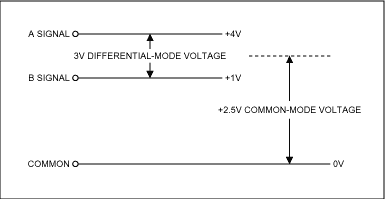共模电压(common mode voltage):在每一导体和所规定的参照点之间(往往是大地或机架)出现的相量电压的平均值。或者说同时加在电压表两测量端和规定公共端之间的那部分输入电压。
差模电压(differential mode voltage):一对导线上电压的差值;
共模、差模正是“输入信号”整体的属性,差分输入可以表示为 vi = (vi+ , vi-); 也可以表示为vi = (vic, vid)c 表示共模,d 表示差模。两种描述是完全等价的。只不过换了一个认识角度,就像几何学里的坐标变换,同一个点在不同坐标系中的坐标值不同,但始终是同一个点。
Signal-Mode Definitions
Electrical signals carried on cables can be described as normal mode, differential mode, or common mode.

差模电压(differential mode voltage):一对导线上电压的差值;
共模、差模正是“输入信号”整体的属性,差分输入可以表示为 vi = (vi+ , vi-); 也可以表示为vi = (vic, vid)c 表示共模,d 表示差模。两种描述是完全等价的。只不过换了一个认识角度,就像几何学里的坐标变换,同一个点在不同坐标系中的坐标值不同,但始终是同一个点。
Signal-Mode Definitions
Electrical signals carried on cables can be described as normal mode, differential mode, or common mode.
- A normal-mode signal is any type (other than common mode) that appears between a pair of wires, or on a single wire referenced to (or returned through) the earth, chassis, or shield. Normal-mode signals are read between two wires in a balanced or unbalanced transmission path. (For a balanced 2-wire path, one wire is driven positive while the other is driven negative by an equal amount, both with respect to a static or no-signal condition in which both lines assume the same voltage level relative to circuit common.)
- A differential-mode signal appears differentially on a pair of wires in an ungrounded cable configuration.
- A common-mode signal appears equally (with respect to local circuit common) on both lines of a 2-wire cable not connected to earth, shield, or local common. Usually, but not always, this is an unwanted signal that should be rejected by the receiving circuit.
Common-mode voltage (VCM) is expressed mathematically as the average of the two signal voltages with respect to local ground or common: Vcm = (Va+Vb)/2
